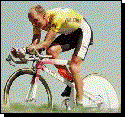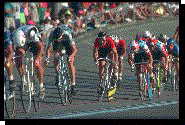














![]()
'97 Review
Cowes
Cricket in the W.Indies
FA Cup
Five Nations
Formula One
Horse of the Year
Tour de France
Wimbledon
Winter Olympics
World Match Play
World Series Athletics
World Snooker C'ship


Tour
de
France
 History ] [
History ] [  Le Tour 1998 ]
Le Tour 1998 ][
 The Race ] [
The Race ] [  Race Winners 1987 - 1997 ] [
Race Winners 1987 - 1997 ] [  Home ]
Home ]

The Tour de France, held annually in July, is probably the most famous European cycle race. It attracts almost 200 competitors from all over the world and lasts about three weeks. During that time the competitors have to cycle more than 2000 miles (3500km) along a set route. This route takes them through towns and villages and up into the mountains. It always finishes in Paris but the start is made from different venues. Often, the route takes competitors through more than one country.
Dates
July 12 - August 2
Facts
Starting Line: Dublin, Republic of Ireland
Finishing Line: Paris
Distance: about 3850 km.
The stages will be divided up as follows :
- 12 'flat' stages
- 2 mountain stages
- 5 high mountain stages
- 2 individual time trials
Links
The 1998 Tour de France
http://www.letour.fr/tour98us/
Map
http://www.letour.fr/tour98us/carte.htm
The first Tour de France was held in France in 1903. It was organised by a French cyclist called Henri Desgranges. It included six stages or sections and covered about 1500 miles. The cyclists who took part used heavy steel bikes without gears. Although the first Tour was only watched by a handful of people - mostly out of curiosity - it soon became popular.
In 1904, some fans tried to sabotage the race by erecting road blocks and spreading tacks on the road to damage the tyres of the cyclists they did not support. Now the Tour is so popular that many towns and cities throughout Europe apply to the organisers for the honour of receiving it. Consequently, the Tour, originally held totally in France, now passes through other European countries. It has started from cities such as Amsterdam, Brussels and Berlin and in 1974 and 1994, part of the route went through the UK!
Famous winners of the Tour include Jacques Anquetil and Bernard Hinault from France and Eddy Merckx from Belgium. They have all won the race five times. Miguel Indurain from Spain is the latest cyclist to join this famous group as the five-times winner from 1991 to 1996.
In 1997, the Tour celebrated its 84th year. It has been held every year since 1903 except during the war years. In the beginning it was watched by a handful of people. Now thousands come to watch each stage of the race in France, while millions all over the world watch it on television.
The Route
The route of the Tour changes each year. Most of it passes through France, but it may cross neighbouring countries such as Belgium, Spain, Italy, Germany, Switzerland or the UK. The Tour is split into 21 stages. Each stage is a section of the route and there is a new stage almost every day. The stages are different distances depending on the course of the route. The longer stages are usually in the flatter areas. The shorter but physically more difficult stages are usually found in the mountain areas. Occasionally, the riders and their bikes are transported to the next stage by aeroplane or train. The final stretch of the course always leads to Paris and the finishing line is on the Champs Elysées.
Competitors
Every cyclist who enters the Tour must belong to a team. The organisers restrict the number of teams to 22 and the number of cyclists overall to 198. Those who are accepted must be of a recognised high standard.
Each team has a leader. This is usually the best cyclist in the team. It is the job of the other team members to help and support their team leader during the race. If he wins then the whole team benefits. The team is also supported by mechanics, coaches, doctors and race officials.
Winning
Every cyclist is timed at each stage. These times are added together so that each competitor has a cumulative time. The cyclist with the lowest cumulative time at the end of each stage is the leader and he wears the Yellow Jersey for the next stage. When you watch the race, you can always pick out the current leader wearing the Yellow Jersey. The yellow jersey may be worn by different people as the race progresses. It all depends on their cumulative times at the end of each stage.
When all 21 stages are completed in Paris, the cyclist with the lowest overall time is the winner. He receives a trophy and he is allowed to keep the yellow jersey.
There are two other Leaders Jerseys worn during the race - the Green Jersey and the Red and White Spotted Jersey. The Green Leader Jersey for is the for Individual Points leader and the Red and White spotted Leader Jersey is for the Best Climber.
| Year | Winner | Country |
| 1987 | Stephen Roche | Ireland |
| 1988 | Pedro Delgado | Spain |
| 1989 | Greg LeMond | USA |
| 1990 | Greg LeMond | USA |
| 1991 | Miguel Indurain | Spain |
| 1992 | Miguel Indurain | Spain |
| 1993 | Miguel Indurain | Spain |
| 1994 | Miguel Indurain | Spain |
| 1995 | Miguel Indurain | Spain |
| 1996 | Bjarne Riis | Denmark |
| 1997 | Jan Ullrich | Germany |
 History ] [
History ] [  Le Tour 1998 ]
Le Tour 1998 ][
 The Race ] [
The Race ] [  Race Winners 1987 - 1997 ] [
Race Winners 1987 - 1997 ] [  Home ]
Home ]

 Le Tour 1998
Le Tour 1998